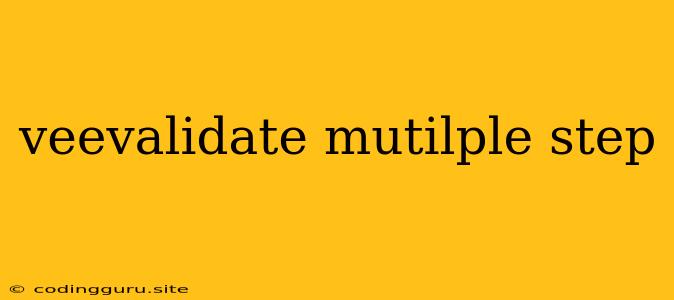Harnessing the Power of VeeValidate for Multi-Step Forms: A Comprehensive Guide
Building complex forms in web applications often involves multiple steps, providing a more structured and user-friendly experience. However, implementing validation across these steps can be challenging, especially when you need robust error handling and clear feedback for the user. This is where VeeValidate comes in, a powerful and versatile validation library for Vue.js that can seamlessly integrate into your multi-step forms.
What is VeeValidate?
VeeValidate is a front-end validation library specifically designed for Vue.js. It empowers developers to create comprehensive validation rules for their forms, ensuring data integrity and providing real-time feedback to users. With VeeValidate, you can:
- Define custom validation rules: Go beyond basic checks like required fields and email formats. Create intricate rules tailored to your specific application logic.
- Validate data on input: Real-time validation provides immediate feedback as users type, preventing errors and improving the user experience.
- Provide clear error messages: Customize error messages to be user-friendly and informative, making it easy for users to understand and rectify any issues.
- Integrate seamlessly with Vue.js: VeeValidate works flawlessly with Vue.js components, making integration smooth and effortless.
Why Use VeeValidate for Multi-Step Forms?
While VeeValidate excels in general form validation, its true power shines when working with multi-step forms. Here's why:
- Simplified validation across steps: VeeValidate allows you to define validation rules for each step of the form, ensuring consistency and preventing data errors from propagating to later steps.
- Centralized error management: VeeValidate provides a single point of control for managing validation errors across all steps, simplifying error handling and display.
- Improved user experience: Clear and consistent validation messages throughout the form provide users with a clear understanding of what needs to be corrected, enhancing the overall user experience.
Implementing VeeValidate in Multi-Step Forms
Let's explore a practical example of how to implement VeeValidate in a multi-step form.
Step 1: Project Setup
- Install VeeValidate:
npm install vee-validate
- Import and configure VeeValidate:
import { createApp } from 'vue';
import App from './App.vue';
import { Field, Form, ErrorMessage, defineRule, configure } from 'vee-validate';
import * as rules from 'vee-validate/dist/rules';
import { localize, setLocale } from 'vee-validate/dist/locale';
import zhTW from 'vee-validate/dist/locale/zh_TW.json';
// Register rules and localizations
Object.keys(rules).forEach(rule => defineRule(rule, rules[rule]));
localize({ zhTW });
setLocale('zhTW');
configure({
generateMessage: (ctx) => {
const { field } = ctx;
if (!field) {
return ctx.message;
}
return ctx.message.replace('$field', `${field}`);
},
});
// Use VeeValidate components
const app = createApp(App);
app.component('Form', Form);
app.component('Field', Field);
app.component('ErrorMessage', ErrorMessage);
app.mount('#app');
Step 2: Defining Validation Rules
In your component, define validation rules for each step using the rules property within the Field component.
Step 3: Managing Form State and Navigation
Use Vue's data properties to manage the current step, track form data, and handle navigation between steps.
Step 4: Handling Form Submission
In the final step, handle the form submission by collecting all the validated data and performing the necessary actions.
Tips and Best Practices
- Use clear and concise validation messages: Make sure your error messages are easy to understand and guide users in rectifying any issues.
- Validate input fields in real-time: Provide instant feedback as users type, enhancing the user experience and reducing errors.
- Consider using conditional validation rules: Apply specific rules based on the values of other fields or the current step in the form.
- Test thoroughly: Test your multi-step form with different data inputs and scenarios to ensure all validation rules are working as expected.
Conclusion
VeeValidate empowers developers to build sophisticated multi-step forms with robust validation, enhancing user experience and data integrity. By leveraging its features and following these best practices, you can create forms that are both user-friendly and reliable. Remember to explore the comprehensive documentation and community resources available for VeeValidate, as they offer valuable insights and support for building complex forms with ease.
